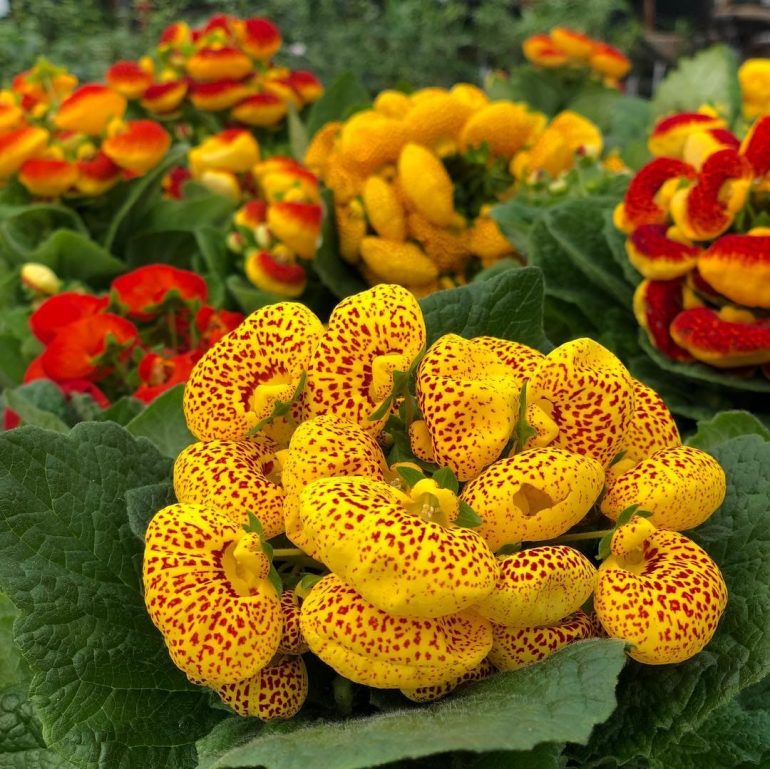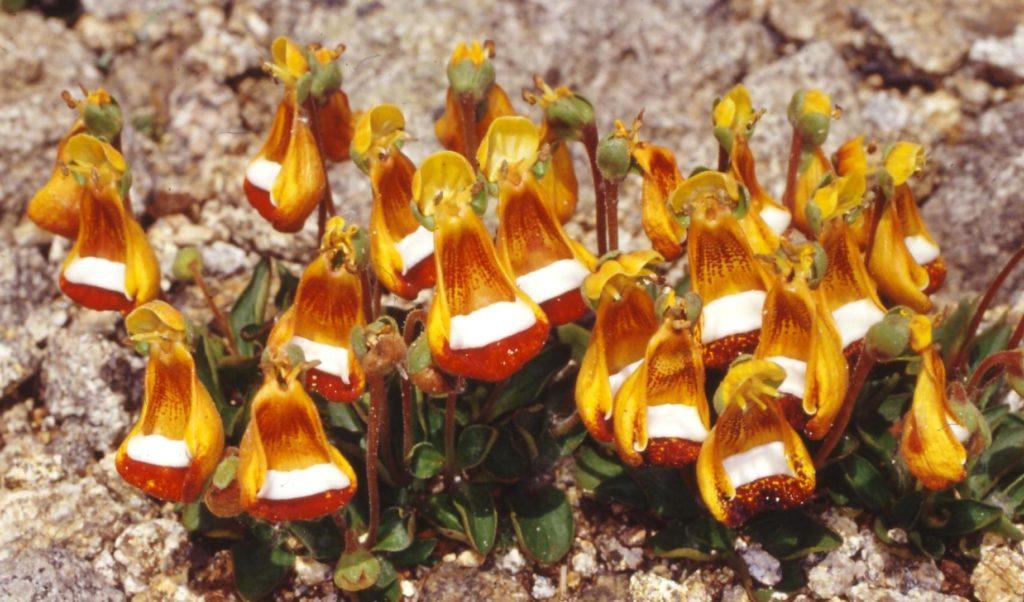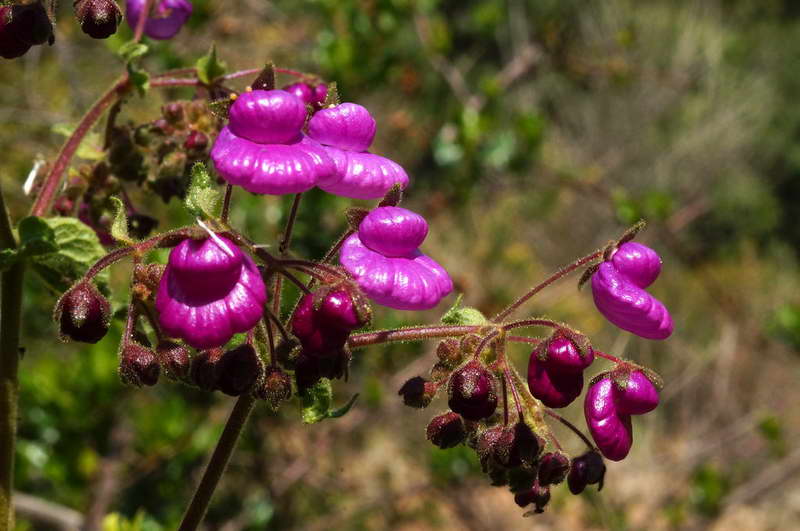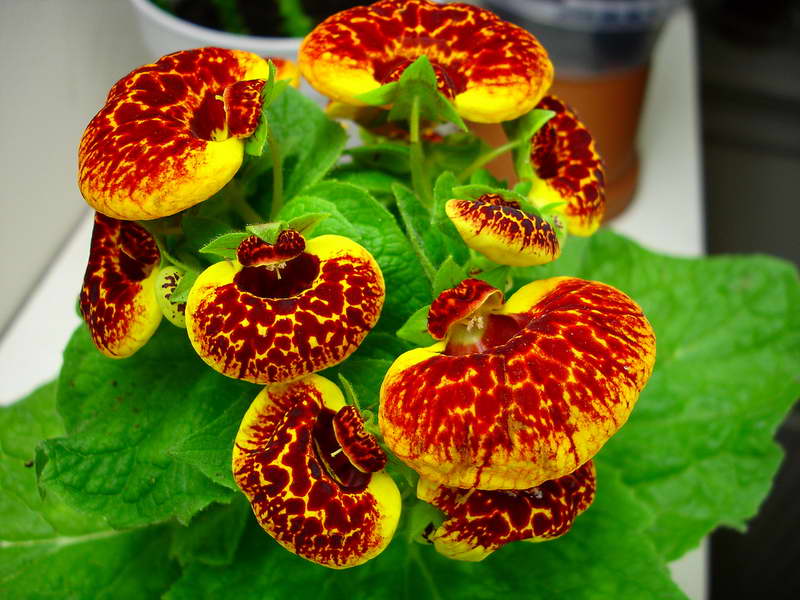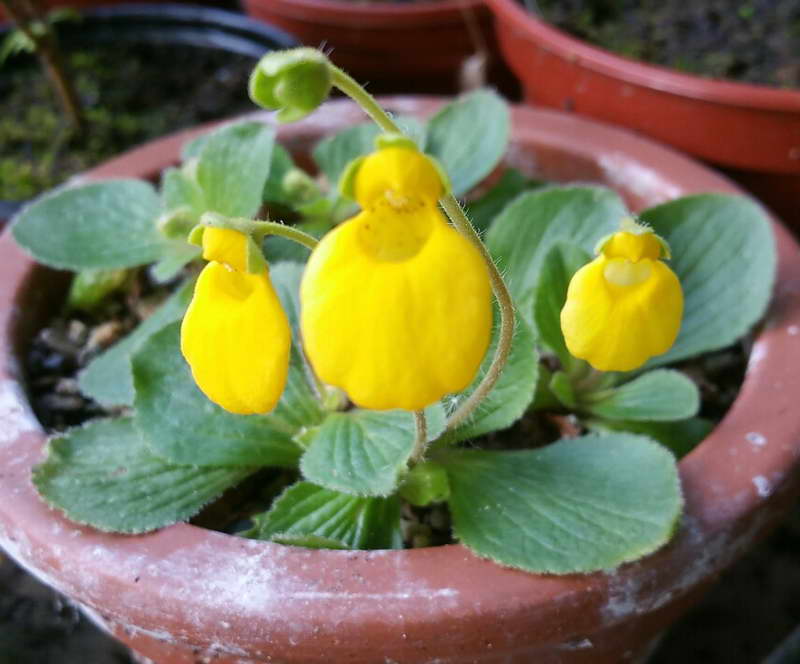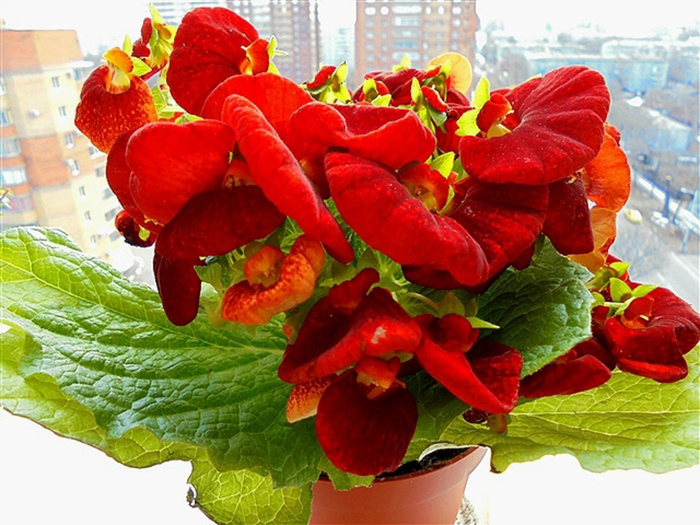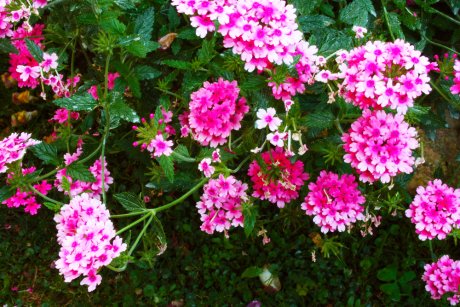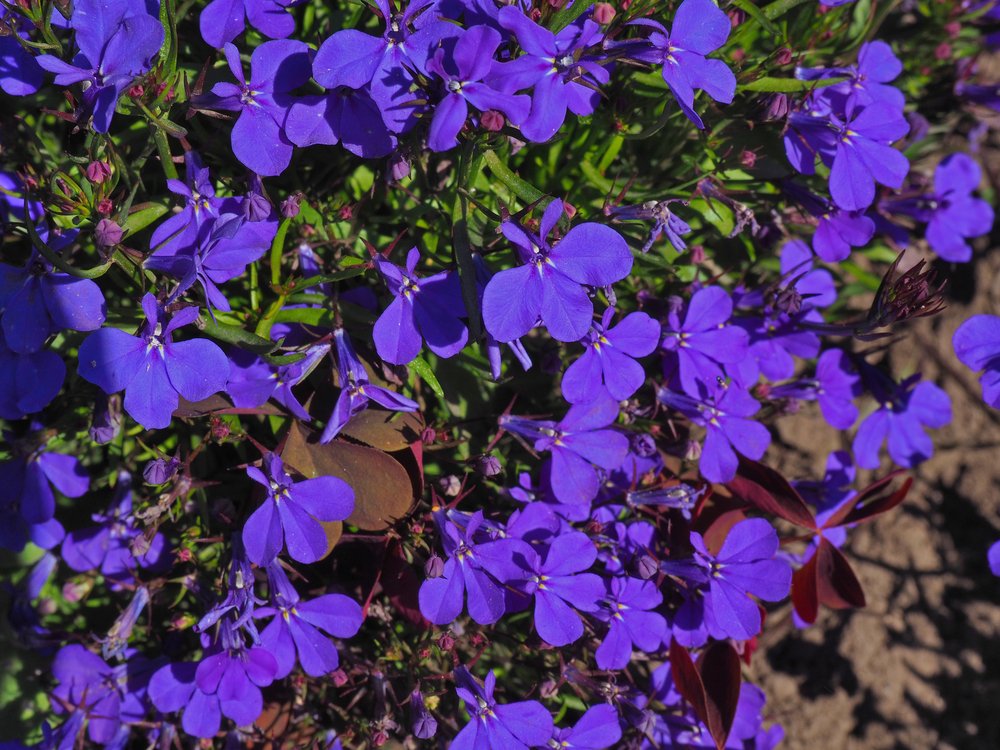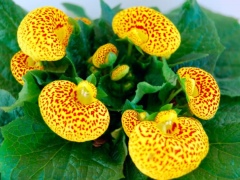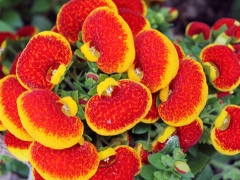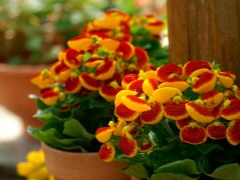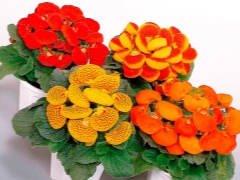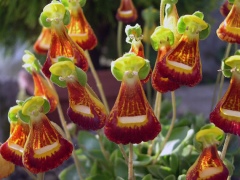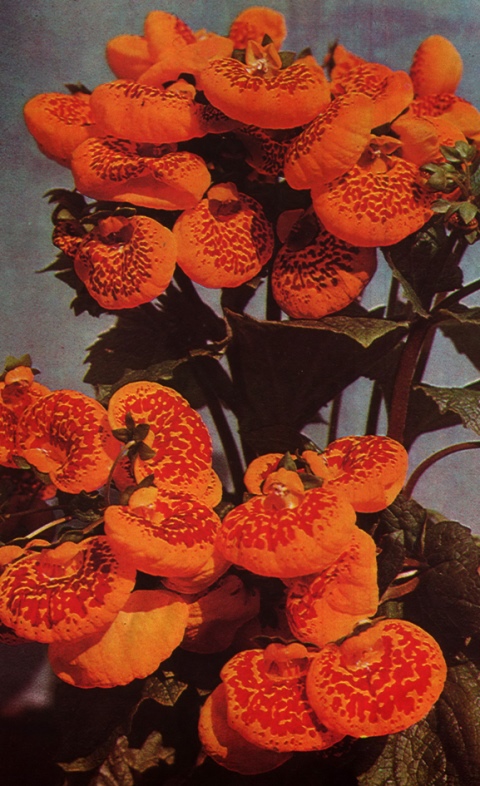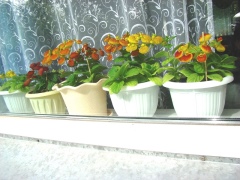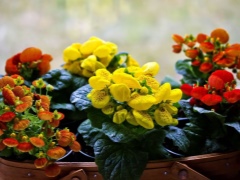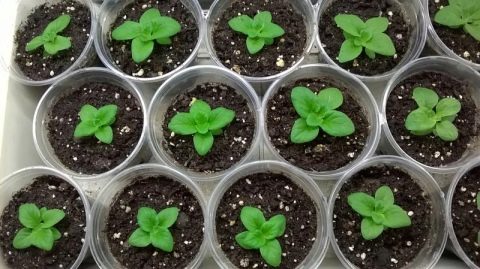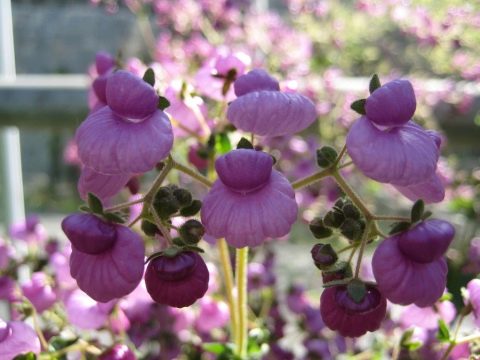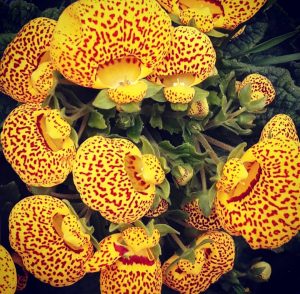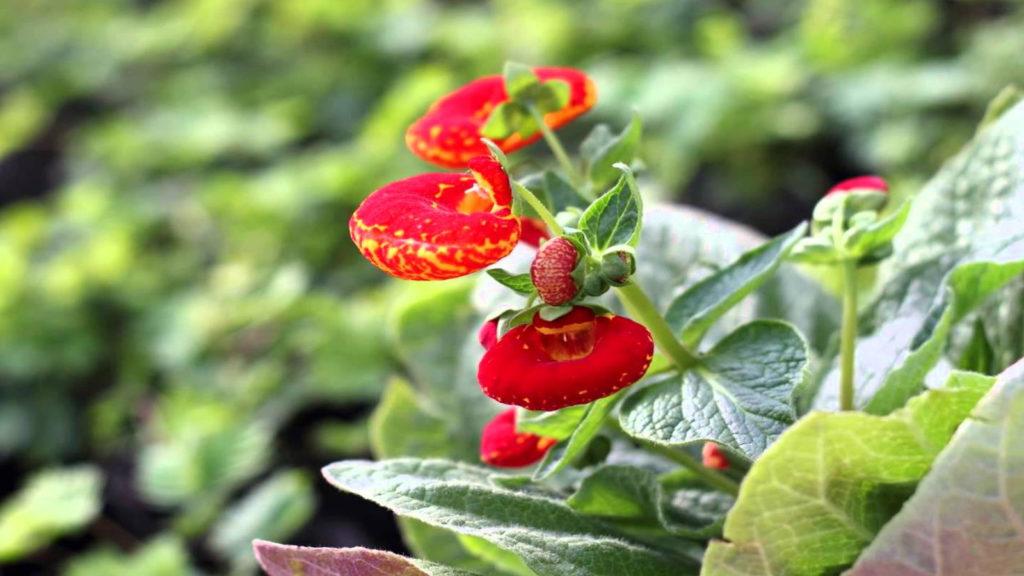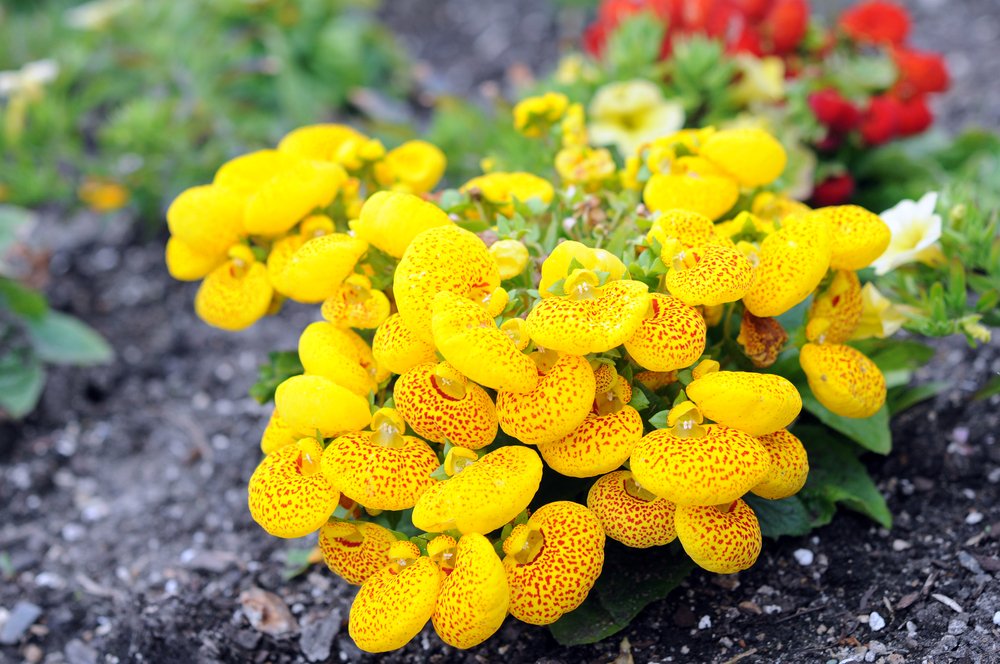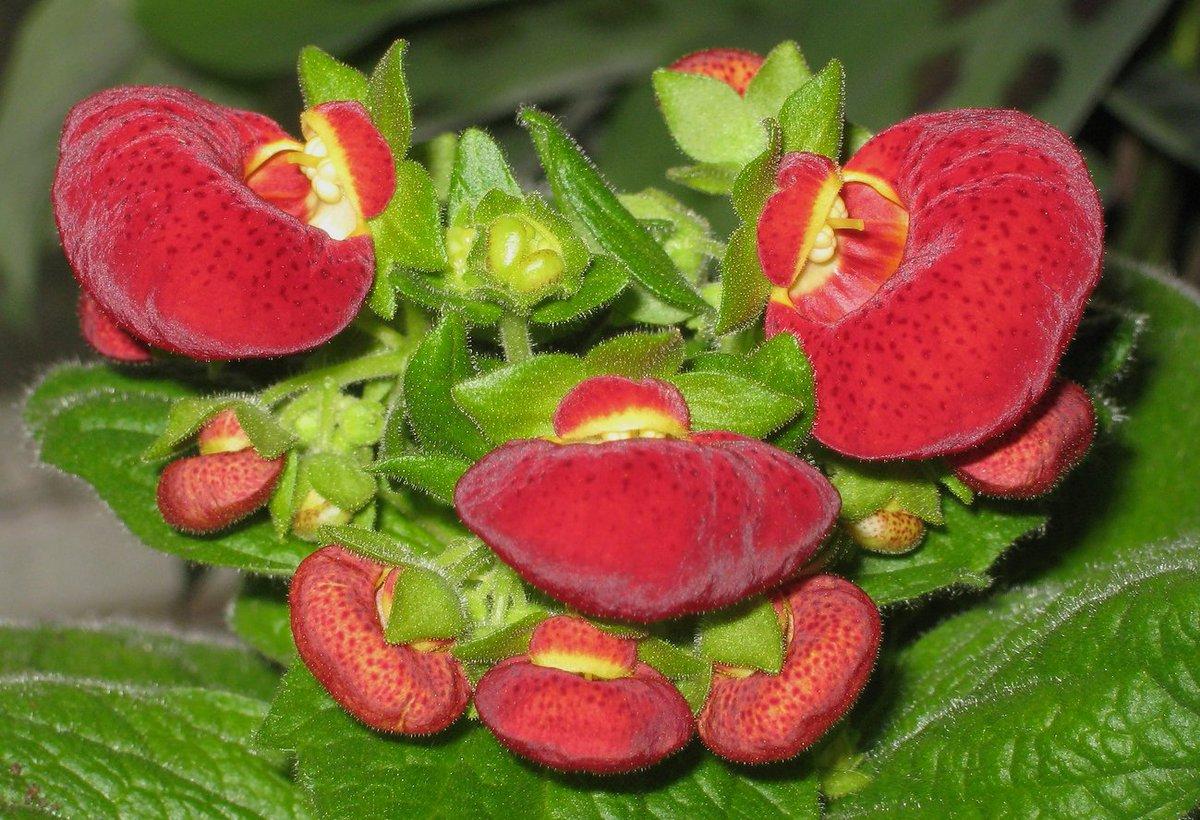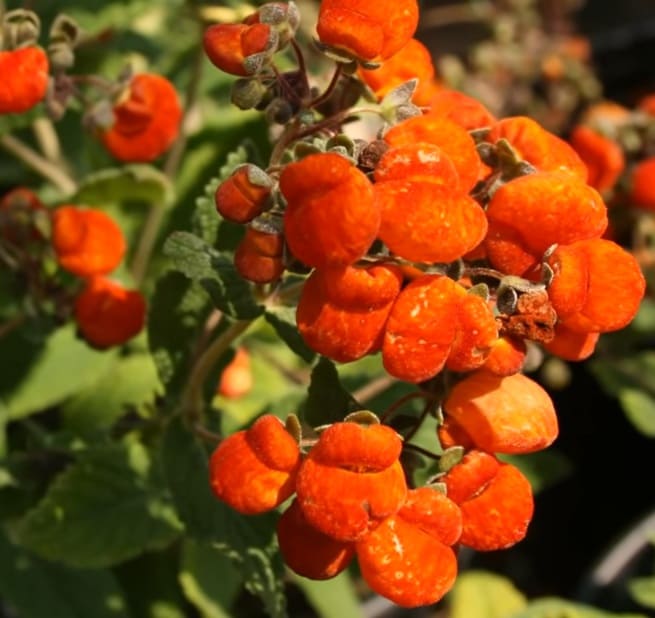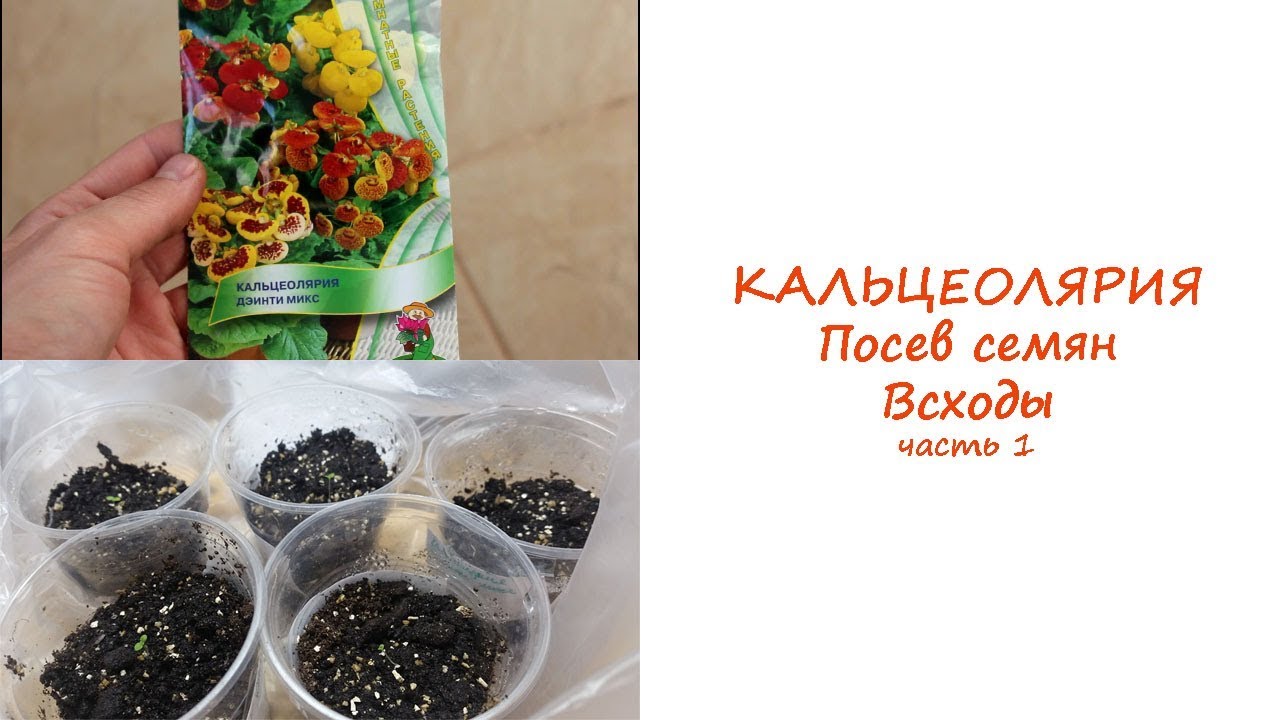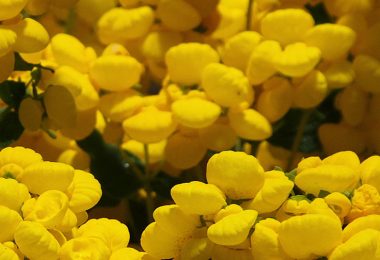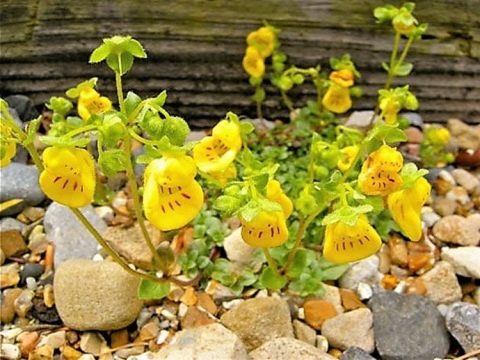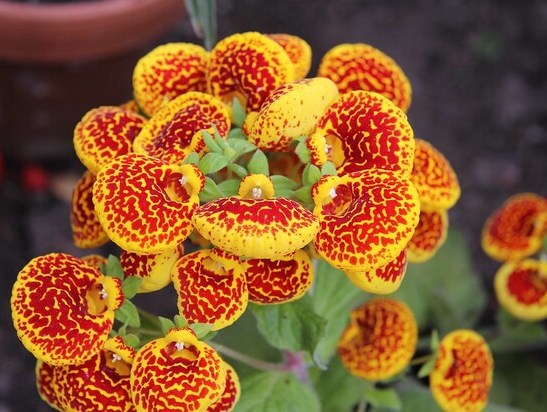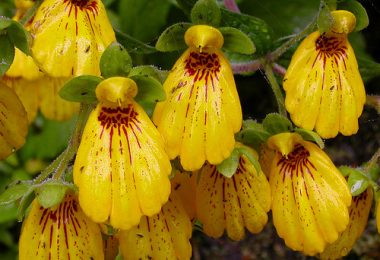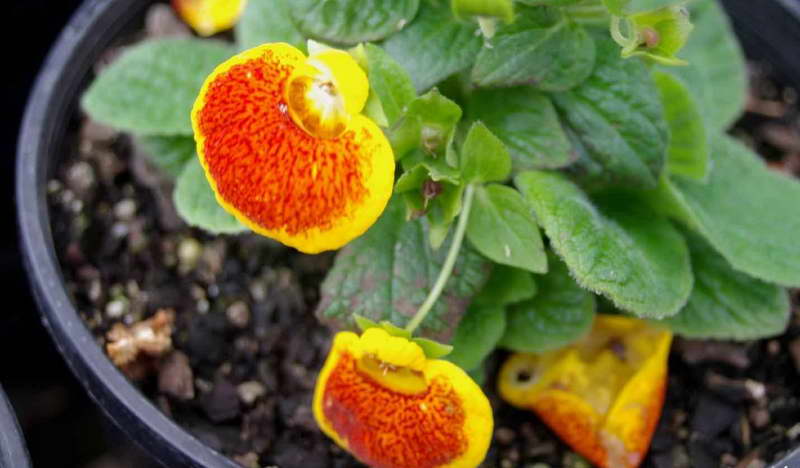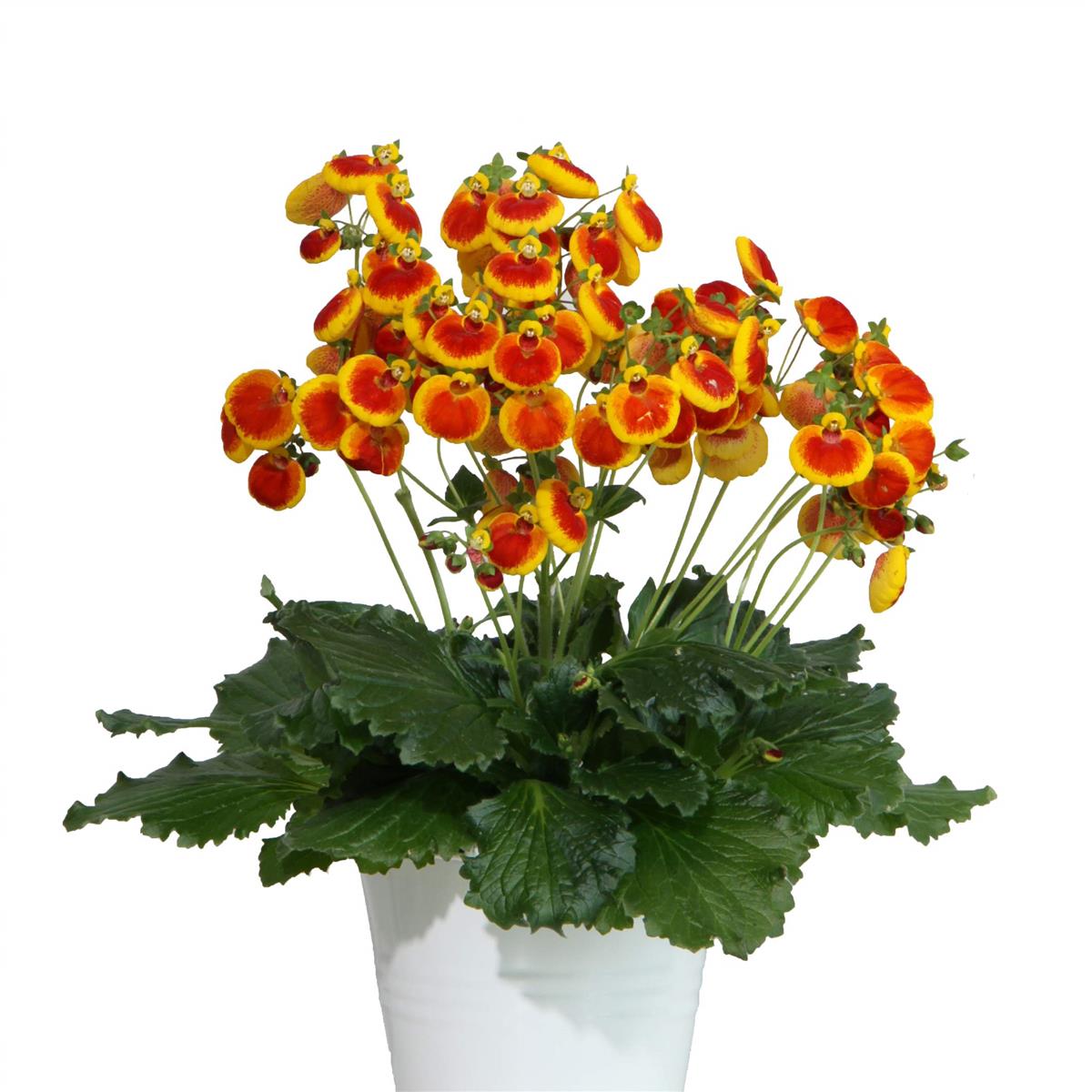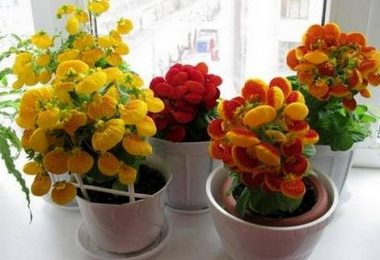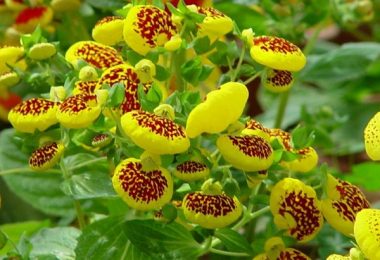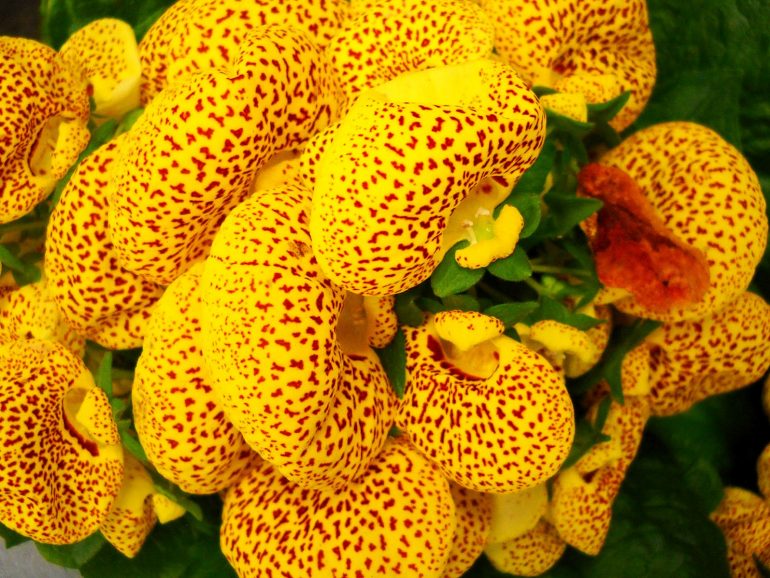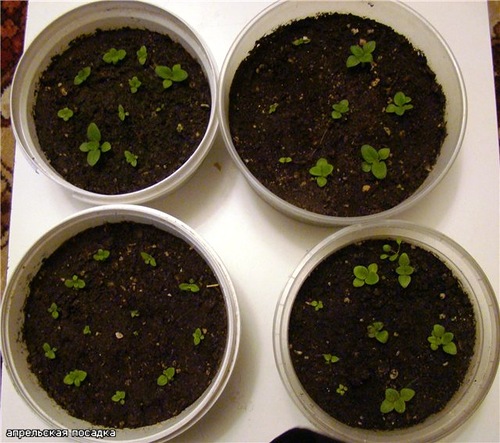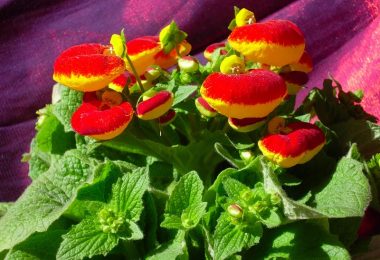Description and varieties of calceolaria with a photo
Calceolaria flower belongs to perennial plants. In height and width, calceolaria has the same proportions of 20-30 cm. The bright green, corrugated leaves of the plant reach 5-10 cm in length. Unusual flowers 2.5-6 cm in size consist, as it were, of two lips. One of them is small and almost imperceptible, and the other is large, spherical, inflated. On one plant, up to fifty flowers can bloom at once. Calceolaria blooms for three to five weeks in April or May.
Calceolaria - species
The following types of plants are most popular:
- Calceolaria purpurea is a herbaceous perennial growing up to 50 cm. The plant is covered with basal leaves jagged along the edges. The flowers are distinguished by an oblong lower lip and a reddish-purple color.
- Calceolaria Mexican can grow from 20-50 cm. It all depends on the growing conditions. It blooms with pale yellow flowers, the diameter of which is about 5 cm.
- Calceolaria wrinkled in height grows to one and a half meters. It has small leaves and small yellow flowers with brown spots. Blooming wrinkled calceolaria looks like a yellow cloud.
- Hybrid calceolaria is a type of plant, under the name of which varieties similar in shape are combined. Basically, they differ only in the color of the flowers. The most common shades are yellow, red and orange. Flowers may have various blots, strokes, streaks or blotches of a different color. The most popular hybrid is the Dundee variety. This graceful plant blooms beautifully with red flowers.
Possible difficulties
Calceolaria is prone to infection with fungal diseases, especially gray rot.
In case of a disease, it is better to cut off the damaged areas of the plant and transplant it into another soil. For the prevention and control of pathogens, EM drugs (effective microorganisms) are used. They improve the quality of the soil substrate and inhibit the growth of pathogenic flora.
It is necessary to strictly adhere to the rules of care, avoid dry soil or stagnant water, provide good lighting and a low temperature.
From the video you will learn about the secrets of amateur flower growers to grow this beautiful plant:
Types of calceolaria
Among all the variety of these amazing flowers with an unusual inflorescence shape, only some of the calceolaria species are grown at home, and they are very successful for creating landscaping. They belong to perennial plants:
- Calceoria purple, this perennial, can grow on average up to half a meter, the leaves extending from the root have an oblong serrated shape at the edges. Flowers of a red-purple hue have the shape of swollen sponges.
- Mexican calceolaria is yellow in color, it can be from 20 centimeters high and above, it all depends on the conditions created for growth.
- The calceolaria flower is wrinkled, differs from all other varieties in the large size of the bush and the iridescent inflorescence that changes from red to yellow. Perennial variety, can be used to decorate flower beds.
- The smallest calceolaria is miniature Darwin, up to 12 centimeters high, yellow with dark spots.
- The calceolaria flower is hybrid, it includes a large number of varieties of the original form, of the most different colors of color inflorescences. From white to bright red, on their peduncles there are various patterns in the form of inclusions, strokes, streaks, but these varieties are more finicky than monochromatic varieties, and more complex care is required for this type of calceolaria.
Caring for calceolaria at home
How to care for calceolaria
In the question of how to care for calceolaria, the most difficult thing is to create the conditions necessary for the plant.Caring for calceolaria flowers is complicated by the fact that heat and dry air are contraindicated for them, and in apartments that are not equipped with an air conditioning system, it is hot and dry in the summer. At home, calceolaria prefers partial shade of the northern, eastern or northwestern window, the temperature is not higher than 15 ºC and humid air, therefore, you need to keep the pot with calceolaria on a pallet with wet pebbles, and water it with soft, settled water so often so that the soil does not dry out.
After flowering, watering is gradually reduced. So that the plant does not suffer from dry air, you can keep the pot in a spacious planter, placing peat between the walls of the pot and the flowerpot, which should be moist all the time. It is undesirable to spray calceolaria. If the plant is too hot and dry, it sheds its buds, is easily affected by pests and generally ages quickly.
Fertilizing calceolaria
Caring for calceolaria involves feeding the plant with soluble mineral fertilizers twice a month, starting two weeks after planting the plant and before flowering. In autumn and winter, the plant is not fertilized, after flowering it is cut off, transferred for a month and a half to two months in a cool, gloomy place, occasionally moistening the soil in a pot. When new growth begins to grow in calceolaria, the intensity of moisture is gradually increased, the plant is moved to its usual place and mineral fertilizing is resumed.
Calceolaria transplant
The overwintered plant blooms two months earlier than calceolaria grown from seeds in the current year, but the decorativeness of last year's bush is much lower than that of a newly planted or purchased one, therefore professional florists recommend that calceolaria lovers buy or grow a new plant every year.
If you are faced with a problem of how to transplant a purchased plant from a technical pot into your own, decorative one, then it is easy to do: put a decent layer of drainage in a new pot, then transfer the plant along with a lump of earth from a technical pot into a decorative one and add land for heather or substrate for geraniums to fill the voids. You can compose the soil for calceolaria yourself, for this you will need two parts of sod and leafy land, one part of peat land and half of sand.
Calceolaria pests and diseases
Of the insect pests, aphids and whiteflies are most often affected by calceolaria. You can try to collect aphids mechanically and destroy, but if the infection is total, then you will have to resort to treating the plant with a chemical preparation actellik, which will help you out in case of damage to calceolaria by a whitefly. If the infection is too strong, it will be necessary to re-treat it after 3-4 days - no more than four treatments are allowed at the same interval.
Of the diseases for calceolaria, gray rot is most dangerous. It occurs when the plant has been exposed to chronic waterlogging for a long time at too low a temperature and too high humidity in the room. Growing calceolaria requires strict adherence to the rules, otherwise troubles can begin. The plant is also weakened by the excessive concentration of nitrogen in fertilizers, which provokes infection of the flower with gray mold. Severely affected areas are removed with a sharp knife, and the plant is sprayed with Bordeaux liquid or oxychom, topaz, cuproscat - any copper-containing preparation.
Reproduction of calceolaria
The plant reproduces in two ways:
- seeds;
- by cuttings.
Growing from seeds
The timing of sowing seeds indoors depends on when you want the flower to bloom. For spring flowering, planting should be done in June, and for autumn flowering - in March.
For sowing seeds, you need to prepare peat soil mixed with sand (7: 1). However, calceolaria does not like sour peat, so it is recommended to add ground chalk to it. About twenty grams of chalk is added to one kilogram of peat.The resulting soil must be well calcined before use.
Calceolaria seeds are very small, so they are simply scattered over the soil surface. You do not need to sprinkle them with anything. It is recommended to put a wet piece of paper on top, moistening it regularly. You need to keep crops in a warm room with a temperature of at least + 18C.
The first seedlings should appear in about two weeks. They should be watered between rows, gently pouring water in a thin stream. As soon as two true leaves appear on the seedlings, they must be dived. In order for the processes to take root well, they can be covered with plastic or glass. Every day, the seedlings need to be ventilated, especially after condensation has accumulated on the glass. Peat should always be moist.
Two months later, the second picking of seedlings into pots with a diameter of 9-11 cm is carried out. Immediately after transplanting, the plant is pinched. Only two or three pairs of leaves should remain on the bush. After a while, young shoots will begin to appear.
Already matured plants are transplanted into flower pots. The soil for this must be heavier and more nutritious. To prepare it, you will need to prepare:
- turf - 2 parts;
- humus - 2 parts;
- peat - 2 parts;
- sand - 1 part.
Calceolaria will bloom, subject to all the rules of cultivation, in 8-10 months from the moment of sowing the seeds.
Cuttings
Cuttings cut after flowering can be tried to root. The optimal months for cuttings are February, March and August. The shoots are dipped in a special rooting powder and planted in a nutritious soil mixture. For the first time, it is recommended to cover them on top with a plastic bag or glass container. In the new place, the cuttings will take root for about two months. To make the calceolaria bush fluffy, several scraps are planted in one pot.
Seed sowing dates
When is the best time to sow calceolaria seeds? There is perhaps no definite answer to this question.
If you want to try planting calceolaria in the garden to decorate the site, then it would be best to sow seeds for seedlings in one of the winter months, no later than March.
True, remember that calceolaria really does not like direct sun and heat, so if you can provide it with shade and comparative coolness during the summer, then it makes sense.
In general, it is customary to sow calceolaria in the middle of summer for flowering in spring and in March-April for autumn flowering. It is during these periods that a lack of flowers is usually felt, so the flowering of calceolaria will be most welcome.
But, you can sow it almost at any time of the year, depending on when you want to have flowering plants. It is best to target a period of 6 months, which usually goes from sowing seeds to flowering. But plants can bloom for several weeks, or even months earlier or later than the intended date. Such are the calceolaria - and it is difficult to do anything about it.
Possible growing difficulties
Calceolaria is picky enough, therefore, in room conditions, especially with improper care, it can be affected by pests and diseases.
- Most often, the plant affects whitefly and aphids. If there are still few pests, then you can try to collect them by hand and destroy them. Otherwise, the bush will need to be treated with special chemicals.
- Gray rot is very dangerous for the plant. This disease occurs as a result of prolonged waterlogging of the soil at low air temperatures or excessive concentration of nitrogen in fertilizers. Heavily affected areas should be removed immediately, and the plant itself should be sprayed with cuprascat, topaz, oxychom or Bordeaux liquid. Medications for the treatment of gray mold must contain copper.
Calceolaria reacts to non-observance of the growing conditions and rules for the care of the calceolaria by yellowing or wilting of the foliage, falling off of flower ovaries, rapid aging or even death of the bush.
Despite the difficulties of growing calceolaria, its decorative effect and beautiful flowering with unusual flowers makes the flower a welcome guest both on window sills and in personal plots.
Calceolaria flower
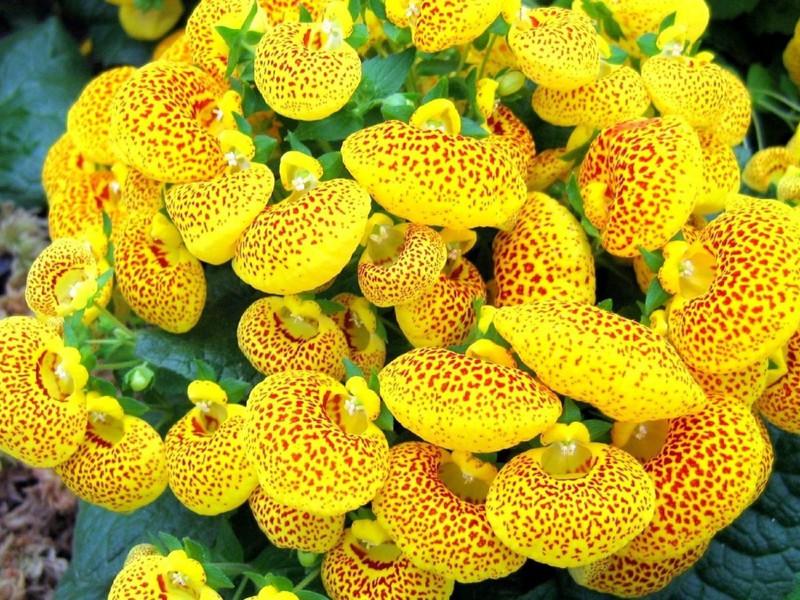
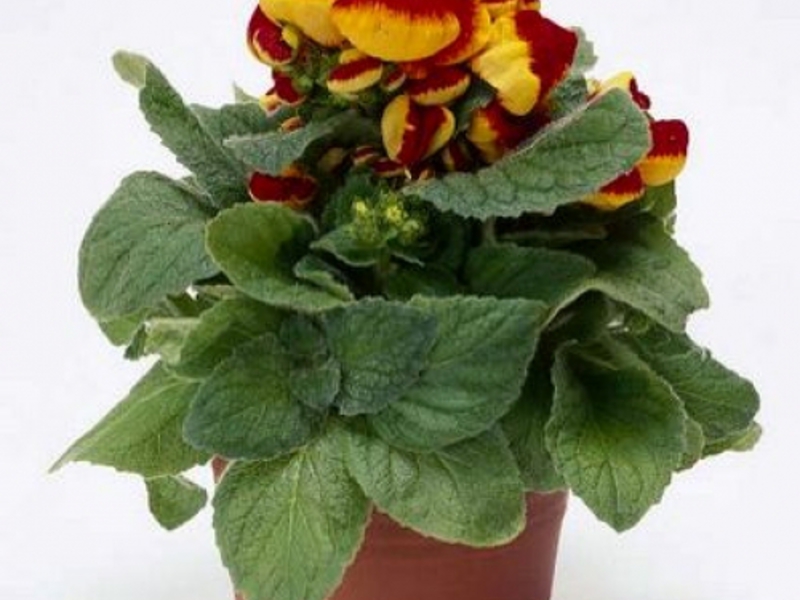
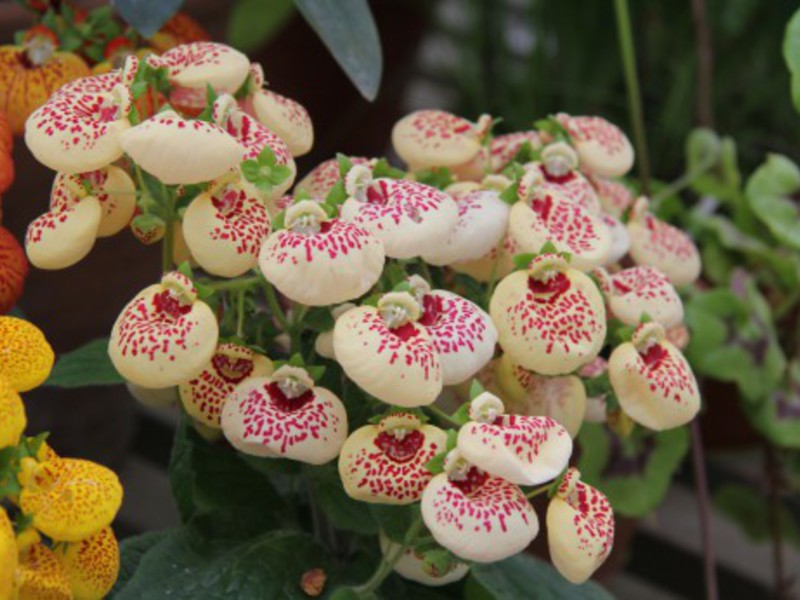
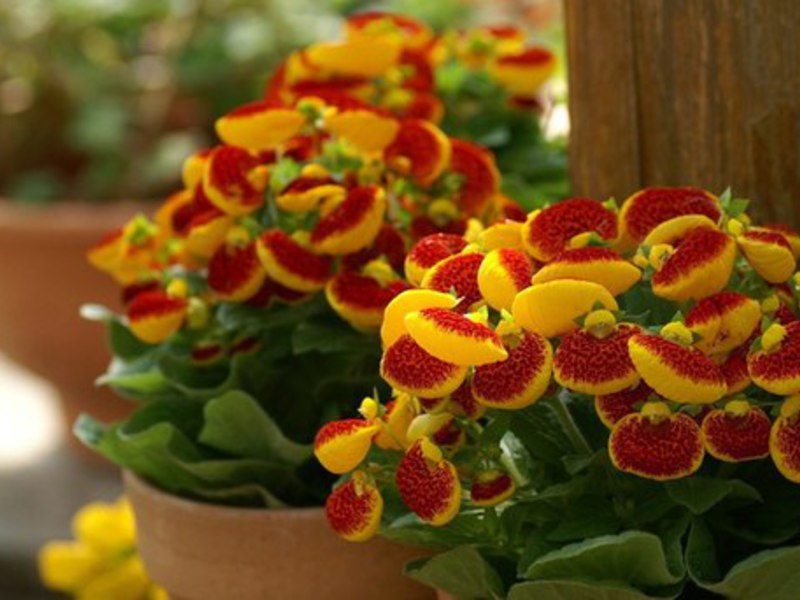
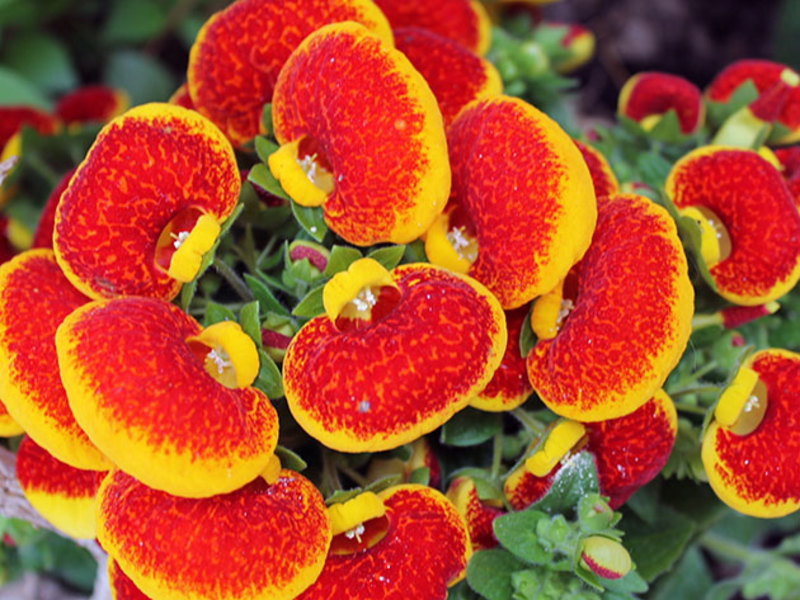
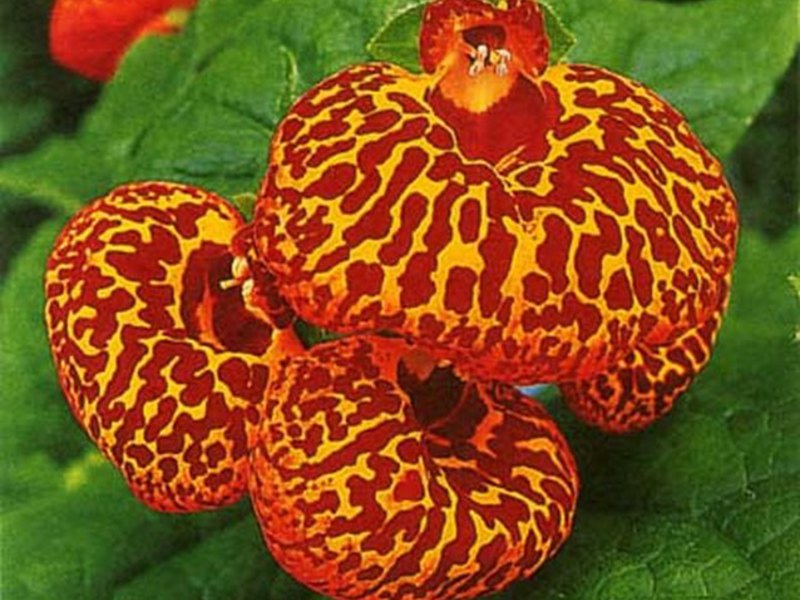
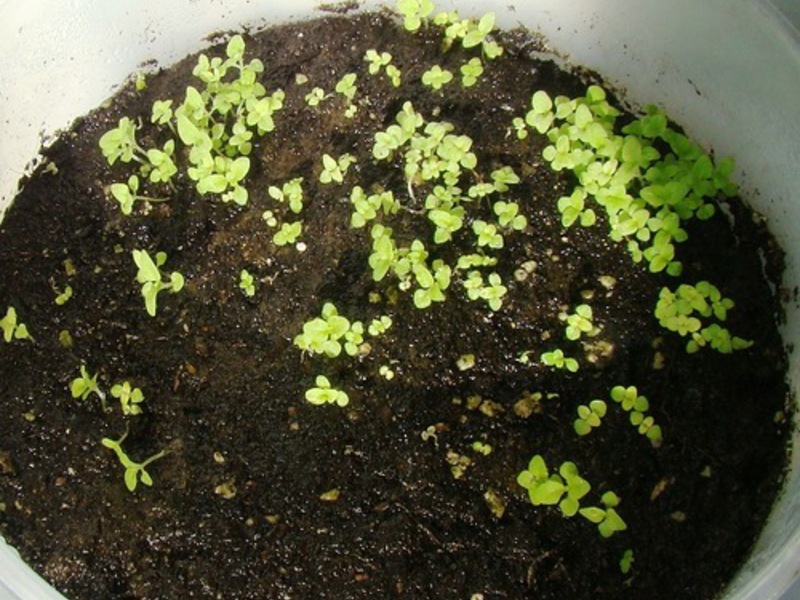

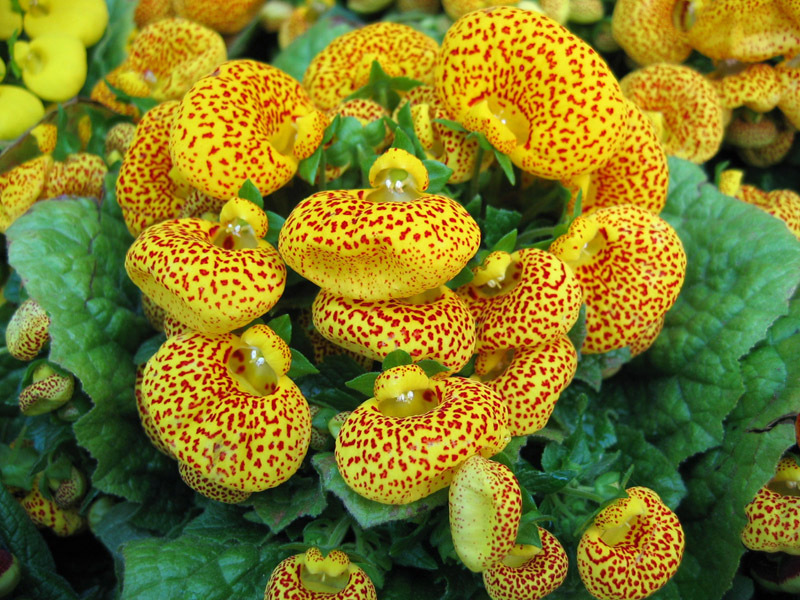


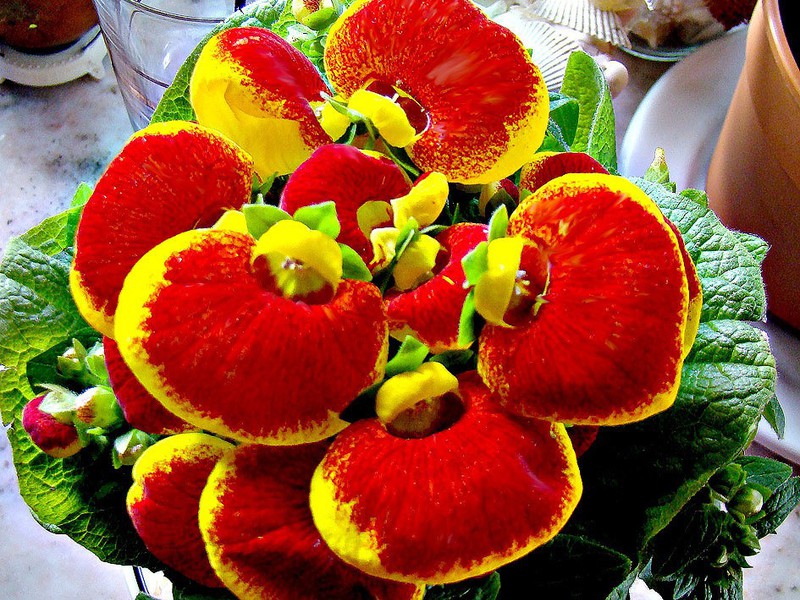
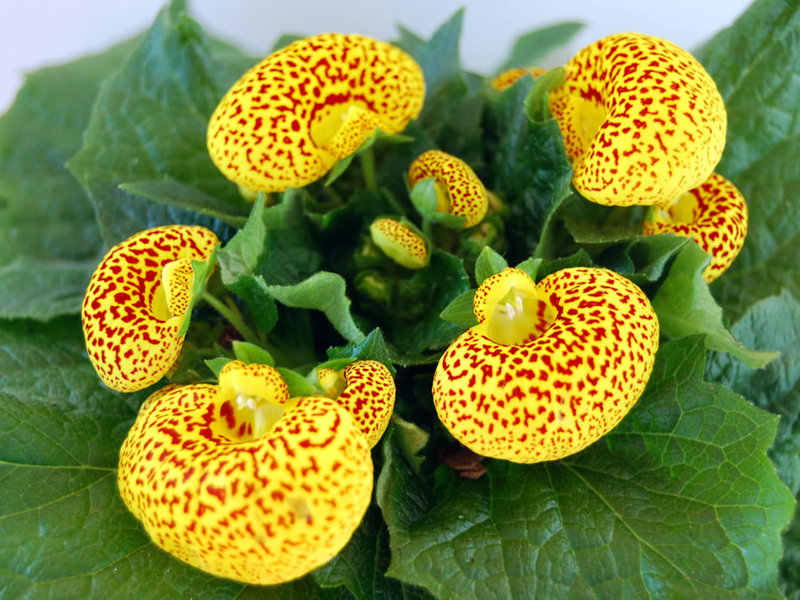
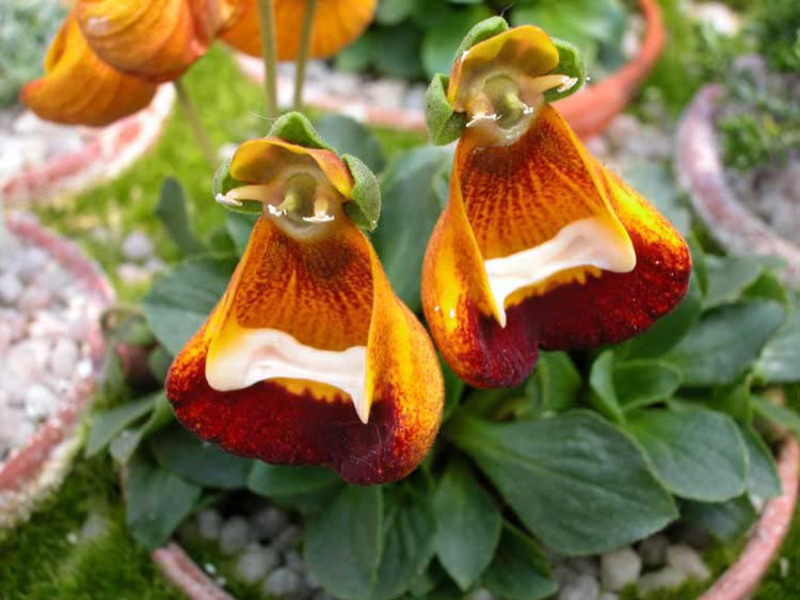

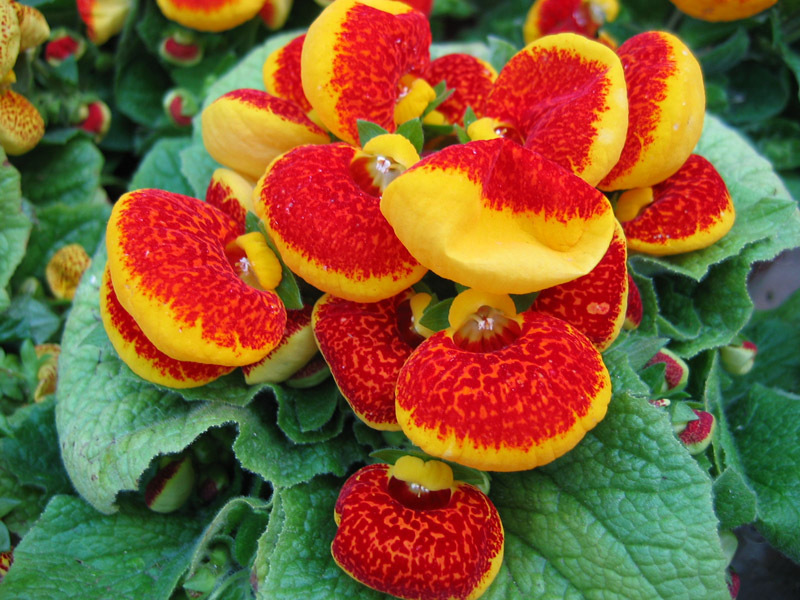
Types and varieties of calceolaria with photos and names
The genus Calceolaria is very extensive: it includes about 300 different species. All of them differ in the size and shape of the aerial part, as well as in the appearance of leaves and flowers. But not every type of calceolaria can be grown in an ordinary apartment. In home floriculture, the following types and varieties are best known:
Hybrid calceolaria (Calceolaria herbeohybrida)

The species includes varieties that have a similar bush shape. At the same time, their sizes can vary from 15 cm to 40 cm. Calceolaria herbeohybrida includes plants with bright monochromatic or variegated flowers. All of them are distinguished by their increased effectiveness during the flowering period. The foliage of hybrid calceolaria is rounded, light green in color and slightly pubescent. It is these plants that are usually used to decorate apartments: they are most adapted to pot growing. Among the main varieties:
- Aida - with velvety, rich red flowers.
- Dainty - forms bushes up to 15 cm tall. The leaves are large, the flowers are colored red.
- Dervish - with yellow-brown flowers in a bright speck.
- Golden rain is a mixture of varieties with brightly colored flowers.
- Tigrovaya is one of the most elegant, but at the same time capricious varieties.
Calceolaria mexicana (Calceolaria mexicana)

The species forms a bush up to half a meter in height. Calceolaria mexicana has branchy shoots. Its flowers are large (up to 5 cm) and have a bright yellow color. Flowering differs in duration.
Calceolaria purpurea (Calceolaria purpurea)
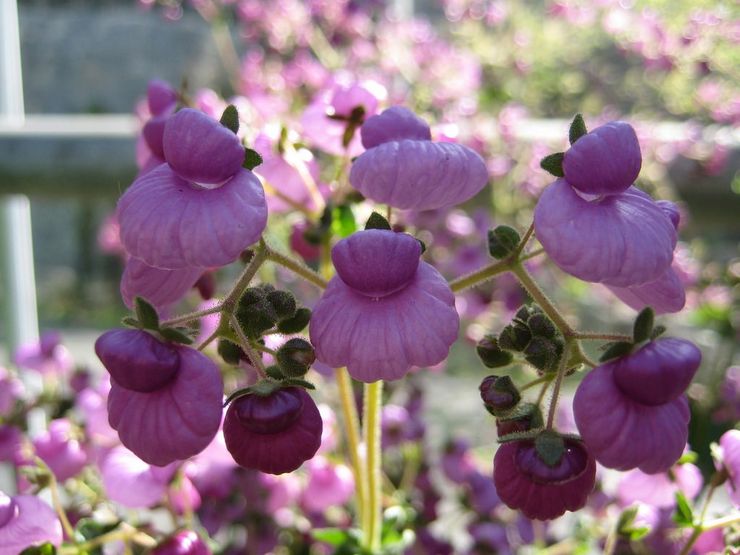
The lower lip of the flowers of such a calceolaria has a more elongated shape than that of other varieties. Calceolaria purpurea is also remarkable for its unusual dark purple or lilac color of its inflorescences. The foliage of the plant has jagged edges, and from the inside is painted in a greenish-lilac color. At home, the species is grown only as an annual.
Calceolaria rugosa

Or whole-leafed. The size of the erect stems of this bush can be up to 50 cm. Calceolaria rugosa has small green leaves covered with wrinkles. During flowering, the species forms many inflorescences, which include medium-sized (up to 2.5 cm) flowers of a rich yellow color. They have a slightly corrugated surface and are decorated with red-brown specks. In the southern regions, the species can be grown in street pots as a perennial or biennial wintering at home. Popular varieties include:
- Goldbouquet - with larger golden flowers.
- Sunset - forms red-orange flowers.
Calceolaria crenatiflora

The bush consists of flexible stems up to 60 cm long. They have short pubescence. Calceolaria crenatiflora produces two types of leaves. The former grow closer to the root and have long petioles. At the top of the stems, the leaf blades are almost devoid of them. Inflorescences-shields consist of yellow shoe-shaped flowers covered with reddish specks.
Cobweb calceolaria (Calceolaria arachnoidea)
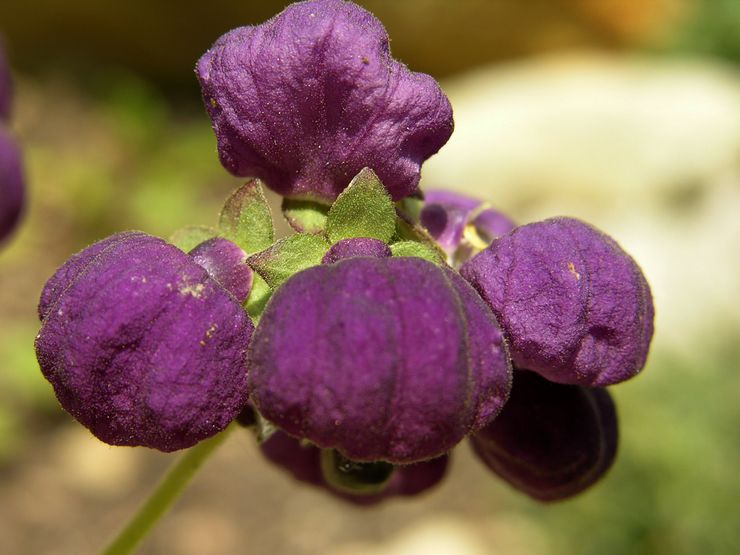
The species is considered quite rare. Calceolaria arachnoidea is only 30 cm tall. During the flowering period, bright red flowers appear on it.
Houseplants Flowering Houseplants
Calceolaria: home care. briefly
The creation of a certain microclimate is the key to successful flowering, since the plant immediately reacts to unfavorable factors:
| Temperature regime | Calceolaria shows the best results at home at low temperatures. |
| Air humidity | Requires high room humidity without plant humidification. |
| Lighting | Bright natural light without prolonged exposure to the sun is preferred. |
| Watering | Moderate watering without excess moisture and drying out of the soil. |
| Priming | Fertile, loose soil with good air exchange and neutral pH. |
| Top dressing and fertilization | Regular feeding with a mineral complex for flowering plants every 10 days from spring to autumn. |
| Calceolaria transplant | A transplant is required in case of purchase in an inappropriate container and seedlings, after sowing. |
| Reproduction | It is carried out by sowing seeds and cuttings. |
| Features of growing calceolaria | Cultivated indoors and outdoors as an annual and perennial plant. |
Choice of place and conditions of detention
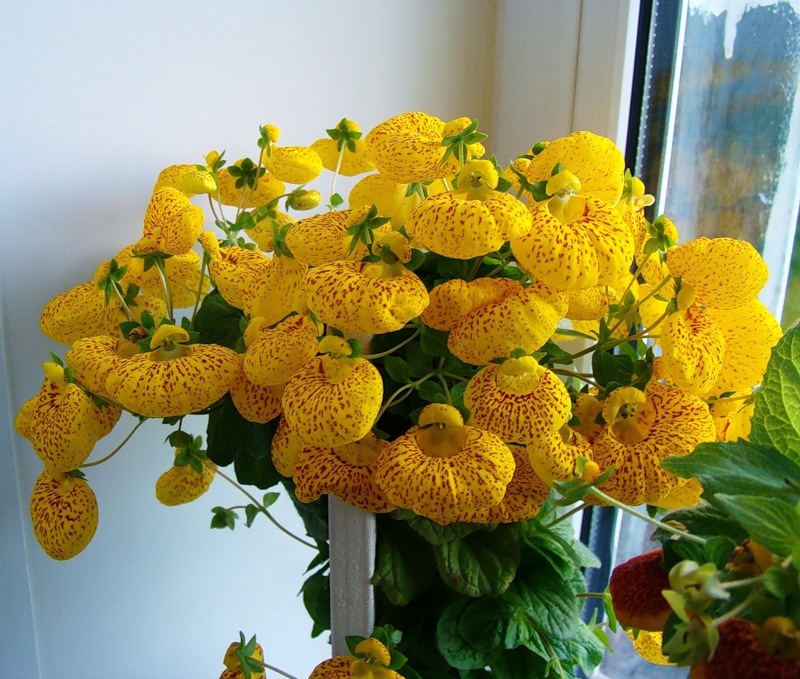
Calceolaria is a very capricious plant, it needs light, but not direct sunlight, it needs a constant temperature of about +15 degrees, so growers advise placing pots with the plant on the northern, eastern and western windowsills. In summer, they can be displayed on a balcony or loggia in a place protected from sunlight.
The plant loves diffused light, it must be shielded from the sun with paper or mesh cloth. During flowering, the plant should be in the shade, and in winter it should be illuminated with special lamps.
The temperature in summer should not rise above + 15- + 17 degrees, otherwise the plant will begin to age quickly and diseases and insect pests may appear on it. In winter, the air temperature should not be lower than + 9- + 15 degrees. At higher temperatures and dry air, the leaves and buds of the plant can fall off.
Around calceolaria, you should try to maintain high air humidity. To do this, it is recommended to spray the air around the flower with water at room temperature from a spray bottle. In this case, do not allow water droplets to fall on leaves or flowers. The pot can be placed in a bowl or pallet with expanded clay and water poured into the bottom. So the flower will receive the necessary hydration.
It is preferable to choose clay or ceramic pots for planting, with a capacity of 0.8-1.2 liters with drainage holes.
The potting soil can be purchased at the store or made by yourself from 2 parts of leafy soil, 2 parts of turf land, 1 part of peat soil and ½ part of sand.
Reproduction of calceolaria
Growing calceolaria from seeds
If you do not know how to grow calceolaria from seeds, purchase from a store or make your own mixture of sand and peat in a 1: 7 ratio with a slight addition of ground chalk or dolomite flour (20 g per 1 kg of soil mixture). Calceolaria seeds are not in short supply; they can be purchased at any large specialized store, including via the Internet. Sowing seeds of calceolaria is carried out in April on a previously disinfected by calcining and moistened mixture, without embedding them in the soil, but covering the container with crops with glass or film, from which condensate will need to be removed as necessary.
Crops are kept in a warm (18 ºC), well-lit place, regularly ventilating and moisturizing the soil by spraying. Two weeks later, when shoots appear, they are watered with a thin stream between the rows. After a month, they are dived for the first time, and after another two months, when rosettes are formed, they are dived a second time into individual pots with a diameter of 7 cm, watered once every two weeks. In September, seedlings are transplanted into pots with a diameter of 9-11 cm and placed in a light and more than cool - 8-10 ºC - room.
In January-February, calceolaria is planted in large pots with a nutrient mixture for adult plants, pinched over 3-4 leaves, transferred to a permanent place and await flowering, which usually occurs 8-10 months after sowing the seeds.
Propagation of calceolaria by cuttings
You can try to root cuttings from shoots cut off after flowering calceolaria. Cuttings can be cut in August, or in February-March. Root the shoots in a nutritious potting mix. Usually 3-4 weeks are enough for roots to appear.In order to get a dense bush, several rooted cuttings are planted in one pot.
Air humidity level
Calceolaria can be safely called a lover of humid air. To ensure a comfortable level of humidity, place the flower pot on a tray of expanded clay or gravel, half filled with water.
It is categorically not recommended to spray the flowers and leaves of calceolaria - there is a soft edge on the leaves of the plant, and the ingress of liquid drops on them is extremely undesirable. Planted pots are ideal for growing calceolaria.
To fill the space between the two vessels, peat is used, which needs constant moisture.
Species diversity
For indoor gardening, it is better to give preference to hybrid varieties of calceolaria, since they are more adapted to life on the window of a living room. Let's take a closer look at the most popular home varieties of this flower.
Hybrid
Hybrid calceolaria is represented by low shrub-type plants, they are distinguished by wide rounded green leaves, rather soft, with a light fluff on the surface. Flowering lasts about 2 months, flowers of various shades - orange, red, yellow with all kinds of specks and blots, the diameter of each is about 5 cm.On the basis of this variety, several popular hybrids have been bred:
- "Aida" is a compact, undersized bush covered with crimson shoes with a velvety surface;
- "Golden Rain" - is a perennial variety covered with very bright shoes of various shades;
- "Dervish" - blooms with small yellowish-brown shoes with contrasting dots;
- "Deinty" is a small compact houseplant, growing no more than 15 cm, is distinguished by rather large drooping and soft leaves, the flowers are red.
Wrinkled (Whole-leaved)
This calceolaria is literally covered with a large number of small flowers, the diameter of which does not exceed 2 cm. The petals are wrinkled, of a rich yellow hue, with small brown specks. At the time of flowering, it resembles a fluffy white cloud. In the southern regions it is cultivated as a perennial that adorns parks and gardens. Calceolaria wrinkled reaches 1 m in height, the flowers are neatly collected in rather large inflorescences, the leaves are narrow, elongated, pale green.
On the basis of this variety, several frost-resistant varieties have been bred that can easily tolerate a temperature drop of up to -5 degrees. At home, such a plant is cultivated as a biennial, which in the summer is grown outdoors in containers, and with the onset of cold weather is brought back into the room.
The most common are the following hybrid varieties:
- "Sunset" - has flowers of a rich scarlet and red hue;
- "Golden Bouquet" - sprinkled with large golden flowers.
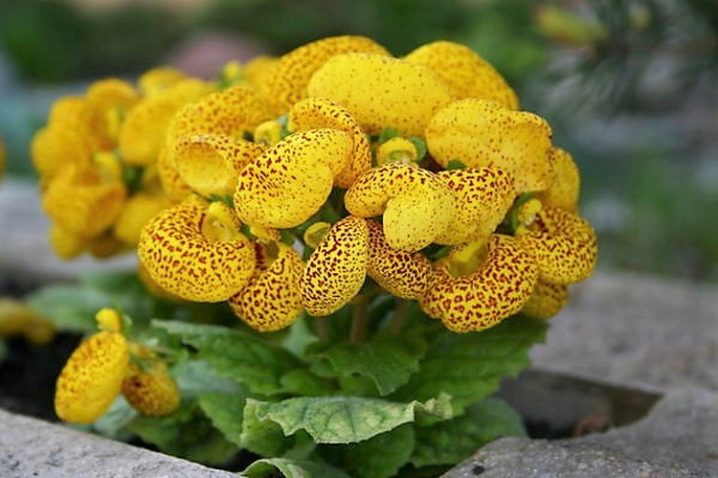
Delicate
This calceolaria is a perennial grown in indoor conditions, and in the summer it is taken out with a flowerpot into the yard, on a loggia or terrace. The leaves are small, rich green, yellowish flowers with dark spots all over the surface.
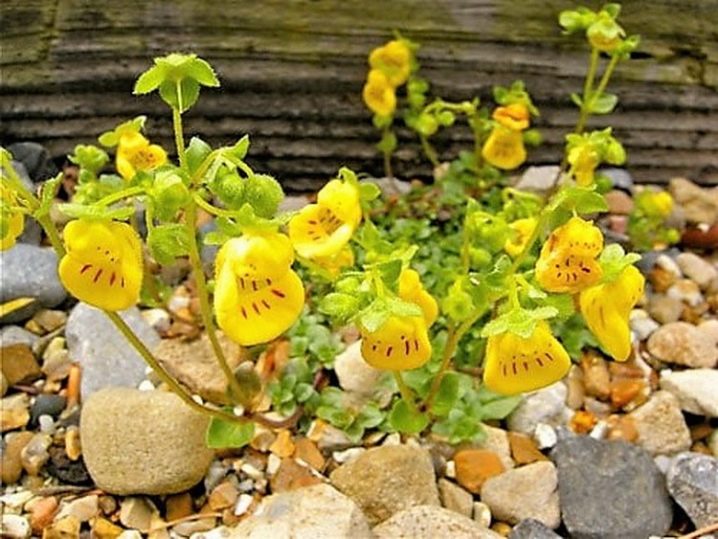
Mexican
Depending on the characteristics of the habitat, its length can vary from 35 to 50 cm, the flowers are golden, up to 5 cm in diameter. Flowering is long, the bush is covered with shoes for 2 months.
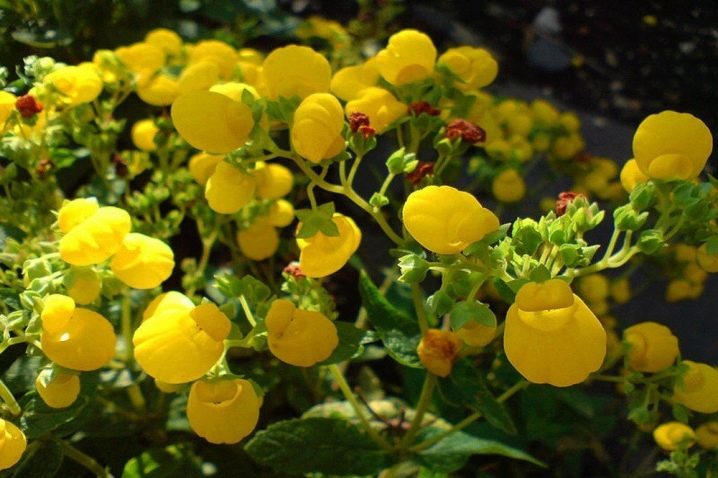
Purple
Low-growing calceolaria, the height of which does not exceed 40-50 cm. The leaf plates are spatulate, with pronounced notches at the edges. The flowers are slightly elongated, purple with a pronounced lilac tint and beautiful dark blotches. In indoor gardening, it is grown as an annual.

Varieties of Calceolaria
- Hybrid calceolaria. It is the most common type of home growing plant. Differs in beautiful flowers of various colors.They can be yellow, white, red and orange. Often, flowers are decorated with dots, streaks, spots of a contrasting color. And it also happens that flowers of different colors bloom on one plant. They are the most capricious and require a lower temperature; in a warm room, the flowers become monochromatic.
- Calceolaria purple. Herbaceous perennial, reaching a height of up to 50 cm. Flowers are small, purple-red with an oblong grooved lip.
- Calceolaria Mexican. Its flowers are very small, about 5 mm, yellow, in appearance they resemble small Chinese lanterns.
- Calceolaria is wrinkled or whole-leaved. Its peculiarity is abundant flowering and plant height - up to 1.5 meters. The red tint of the flowers gradually fades to yellow. This is a perennial species that is grown in the open field in the southern regions, and indoors in the northern regions.
- Calceolaria is multi-root. It has a liana-shaped creeping stem, yellow inflorescences, can be grown both in the garden and indoors.
- Miniature Darwin's calceolaria. It grows no higher than 12 cm, the flowers are yellow with brown spots.
- Calceolaria is thin. Differs in lemon color of flowers and an average height of the bush - 35-40 cm. Can be grown outdoors and indoors.
- Calceolaria is tender. The plant is miniature in size - 6-8 cm in height. The flowers are golden yellow in color with red streaks extending from the center.
Reproduction of calceolaria
Calceolaria plant, reproduces in two ways:
- Seeds and
- Cuttings.
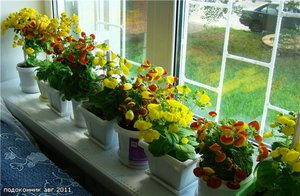 As soon as the flowering period ends, calceolaria can be bred from cut cuttings; for this, the prepared shoots are immersed in a rooting solution and planted in a prepared nutritious soil mixture. After that, it is necessary to cover it with a glass or plastic container, constantly maintaining the necessary humidity. The first shoots may appear, after one and a half to two months, the best period for obtaining cuttings is the last winter month, the first spring and the end of summer.
As soon as the flowering period ends, calceolaria can be bred from cut cuttings; for this, the prepared shoots are immersed in a rooting solution and planted in a prepared nutritious soil mixture. After that, it is necessary to cover it with a glass or plastic container, constantly maintaining the necessary humidity. The first shoots may appear, after one and a half to two months, the best period for obtaining cuttings is the last winter month, the first spring and the end of summer.
When planted with cuttings, this flower loses its decorative effect, because of this, experienced florists advise to breed calceolaria by sowing seeds. In the prepared soil, seeds are sown superficially, that is, they are not covered with earth, since they are very small, and to make it easier to do this, they can be mixed with talcum powder. After sowing, the plantings are carefully watered, and covered with a film on top, who uses soft paper that is constantly kept moist. The box with seeds should be placed in a cool room, where the air temperature will not exceed 18 degrees, and there will be no direct sunlight.
After germination from seeds and the appearance of the first leaves, the covering material is removed, and it is necessary to maintain optimal humidity. At two weeks of age, the seedlings are dived for the first time, transplanted into other boxes with nutrient soil at a distance of at least 4 centimeters. The main thing when caring for plants at this time is to maintain the necessary moisture, it is best to add water to the pan so that moisture does not get on the leaves, as this can lead to the development of gray rot, and it can destroy delicate sprouts.
After the formation of a full-fledged rosette and a good root, the flower must be dived again, but for transplantation, pots or flowerpots are needed for its constant growth. Plants are pinched above the third leaf, to create a compact bush with a large number of flower buds. The air temperature during the growth of seedlings should not exceed 18 degrees, the room should be light, but exclude direct sunlight, preferably diffused light.

